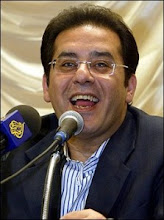After the conclusion of the official reception of my trip with Amr Mousa to Gaza on the occasion of opening the first session of the Palestinian National Council, I received an invitation from a Palestinian Member of Parliament to attend a meeting at the Social Club of Gaza. His name, as far as I remember was Hamadah El-Fara’ena.
In that meeting, I was introduced to a high profile group of Palestinian leaders who belong to the Intifada generation. The most prominent among them were Marawan Barghouthy from the Fatah movement, Abdul Khalek Al Natshah from Hamas, in addition to some other independent political activists.
In the meeting, I had a feeling that I am seeing a different Palestine, unlike the one I left in despair at Arafat’s house, which I sneaked out of to attend the activists’ meeting. There, I saw a real image of the fire burning inside Palestine! I was transformed from a cold conversation at Arafat’s house about personal memories on public and private meetings and phone calls to a real hot debate on the future of Palestine, criticizing the newborn presidency, constitution, and Oslo 1993.
I was an eyewitness to the exchange of serious accusations between liberal and independent leaders. They mentioned the absence of transparency and democracy. They were preoccupied by the involvement of the Palestinian Authority with the ill mechanisms of building the state via importing the worst examples of ruling regimes in the Arab world. They did not want individualism, monopoly, and corruption to be the pillars of establishing the newborn state. They also had big doubts regarding the injustice of diplomatic developments.
The representatives of Hamas, in the meeting, discussed the fragile balance indicated in Oslo and described it as a “domination peace!” This term stole my ears and I could not forget it until I read it again in Raymond Irawan’s book Paixet Guenne Entx Leanationa in 2004.
I saw the power of the Intifada removing the accumulated clouds of division and weakness in the sky of Palestinian national unity. It strengthened hope in reaching a comprehensive and unified solution.
Israel succeeded in planting a burning cord into the powder keg, by involving Arafat, and later, Abbas, into transformational phases, which gave the Israeli side more space to impose a negative rhythm on the development of social movements. They ran into signing conventions based on the logic of steps and testing the ability of the newborn authority to guarantee Israel security – or rather, suppressing Islamist radicals and secularists.
The internal crisis of Palestine cannot be reduced to the conflict between Fattah and Hamas, or illusionary (made in USA) groups of “moderates” and “extremists.” This is a mere echo of the naïve division of the world into the “Empire of Good” and the “Empire of Evil” by Reagan in his infamous Orlando Florida speech to the National Association of Evangelicals on March 8, 1983. The same concept came to the surface once again by Bush after the September 11 attacks.
My evidence on the inaccuracy of this reduction of the internal Palestinian crisis to a conflict between moderates and extremists is that the majority of Palestinian politicians who participated in the aforementioned meeting are in jail, now.
If we look into the “Prisons” Initiative launched by Marawan Barghouthy of Fatah and Abdul Khalek Al Natshah of Hamas, we realize that the Palestinian-Palestinian conflict is not a conflict between moderation and extremism. It is a conflict between two views of managing a homeland which is not found yet.




No comments:
Post a Comment